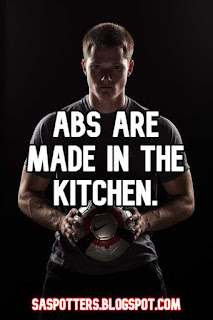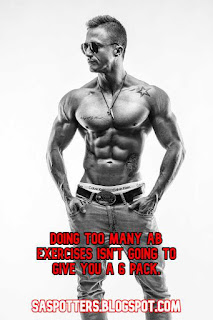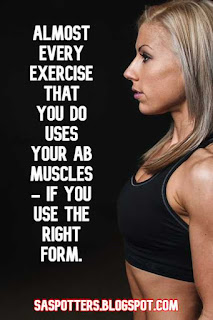 |
| Focus on your diet to get abs. |
Article by Rob Maxwell, M.A. Exercise Physiology, CSCS, ASCM CPT from fittothemax.net
Abs are made in the kitchen
Repeat after me, "Abs are made in the kitchen!"
 |
| Crunches aren't enough for abs. |
What does it mean that abs are made in the kitchen?
Many people want abs. If you know what this statement means, then you know what that means. If you do not, let me explain.
The term abs is short for abdominal muscles. And when I say that many people want abs, what I mean is that they want their abdominal muscles to show. They want definition. They want what is often called a six pack.
This just means that abdominal muscles are showing very clearly. In short, many people want to have a defined looking midsection. To get that look it comes down to diet and not spot reduction. Abs are made in the kitchen because you need to focus on diet to have your abs showing. It's more about fat reduction than it is about muscle growth to get abs.
 |
| Ab definition is relative to fat mass. |
Spot reduction doesn't work
Spot reduction refers to the idea that you can exercise a certain part of your body to make it smaller. You cannot. To be more specific with what I am talking about, spot reduction of the abs is a belief that if you do a lot of stomach exercises such as hundreds of crunches, you will make your midsection smaller.
Simply put, this is not true. When we strength train (and that is what a crunch is), we make an area stronger and make it hypertrophy (grow the muscle). We do not make it smaller. If anything, we make the specific area bigger!
Don't worry, though. The abdominal muscles are such that even as they get bigger, they do not grow outward. But the obliques on the sides of the lower torso can get bigger and stick out more. Many top bodybuilders that are looking for more symmetry do not train their obliques for this reason - because they do not want to look "blockier.”
 |
| A 6 pack doesn't come from crunches. |
 |
| Don't waste your time for limited results. |
How to get a 6 pack - the right way
When I tell people that many top bodybuilders hardly work their abs, they do not believe me.
But it is true. They have awesome looking midsections because they stay so lean. They work their core by keeping great focus on their abs as they do their other exercises.
For example, if they are doing rows, they focus on keeping their spine nice and straight and contracting their abs to help them do this. They understand that the abdominal muscles are a major stabilizer muscle, and that they are using them when they strength train regardless of the exercise.
 |
| Use your abs in every exercise. |
By doing that, hardly any work at all is needed to keep your abs strong. The bodybuilder understands that to get their abs to look defined has nothing to do with the exercise, but everything to do with being lean.
If you are a male with 5% body fat (females should have a higher percentage of body fat by about 10%), you will have an awesome midsection and a six pack irrespective of whether you have ever done a crunch.
If you are 20% body fat (which is average for a male) and you do abdominal work every day, no one will see these abdominal muscles.
Having great abs is about being lean. To be lean, you must take in fewer calories than you use, period.
If you want the abs to look better, you really need to eat clean and eat just what you need (a calorie deficit). Once you reach that goal, you eat just the amount you need to maintain.
I have competed. I do some core work, but not a lot. I should clarify that. I do focus hard on the lower back because I want that muscle to be strong. The lower back is part of the “core.” But I do not do a lot of anterior abdominal exercises. I do some to maintain their strength.
As I said above, I really focus on keeping my core engaged on every exercise, so I do not need to do a lot.
Why don’t I do more? It is boring to me. I do not like doing it. And I know how pointless it is overall. It is hard for me to get motivated to do something that I know is not really benefiting me.
I really hit the lower back muscles hard, though. I do not want my back to be weak.
Let's go back to competing. When I competed, my abs looked good. I have a six pack and I do try to stay lean like that. I do not want to go up and down. But there have been times when I have not been as lean, and guess what? My abs are not what you would call ripped when I am not as lean.
Abs are made in the kitchen. I tell any client who wants to lose body fat. We must watch what we eat (the quality and the quantity of food) and we need to do our cardio to burn the fat and reduce the calories.
If we do that and we do it consistently, we will get lean and the abs will show up! How much they show up is 100% dependent on how lean they are. Women will need to be around 14-17% body fat to show that kind of development and men around 5-8%.
 |
| Get lean to get abs. |
Keep in mind that all of our bodies have a set point. Not everybody can get lean enough to show the abdominal leanness. And that is okay!
I am not writing this with the motive to shame people into thinking that a 6 pack is the be all and end all. It is not! I have seen abs on both men and women that are shredded and, to me, look very unattractive. It is about taste.
I am just saying that if you’re on a quest for six pack abs, you’ll find them in the kitchen and on the treadmill!
Muscle imbalances
 |
| Get lower back strength. |
How to train it right
Let us say that your motive to exercise the core is because you want to train the core for strength. Good!
Again, my first tip is for you to really engage the core in all that you do. That is truly the best core exercise you can do. It is like doing a plank all the time! And work your core muscles (rectus abdominis, transverse abdominis, obliques, and erector spinae) all in balance. Pick an exercise for each (you can vary it).
Work the rectus abdominis by doing a crunch or a reverse crunch—any movement that flexes the spine. Work the transverse abdominals by doing a plank type movement. Work the obliques by doing side bends or rotations. Work the lower back by doing spinal extensions either on a machine or with your own body weight.
Do the 1-3 sets of 10-30 reps (and 45-60 seconds for plank). Do NOT do 100 crunches or 1000 or whatever. That is just silly!
If you do follow these principles, and do it mindfully with enough load, your core will get stronger.
Speaking of load, here is another issue with the 1000 crunches guy, it is not enough load! Would you do that for your biceps?
You still need enough of a load to fatigue the muscle in a low enough rep range. If you can do more than 30 abdominal flexion reps and you are not feeling it, you need to find a way to add load. The abdominal muscles are made of the same tissues as any other muscle in your body.
For them to make progress, they need to be overloaded. Regarding the plank, holding the plank longer (more than a minute) is not making progress. If you want to effectively overload the plank exercise you make the planks harder not longer. For example, doing a plank on a stability ball would be a good overload.
 |
| Find what actually works. |
Focus on what you eat
The core exercises discussed above are for strengthening the core. If you want defined abs, spend a lot more time focusing on how you eat and how much your shoes are contacting the ground.
If you create a calorie deficit over time and you have the genetics to get lean enough, your abdominal muscles will look cut!
I know what you are thinking. You are thinking that it is a lot easier to do 2000 crunches than watch what you eat. I know. I get it.
A lot of people train abdominal muscles because they are easy to do. But easy isn’t worth it, right? It is hard to flex those muscles of discipline and tell yourself to really watch and control what you eat.
Again, I get it. But it is the only way. It is hard for almost everyone. Why almost? Come on, we’ve all seen the little surfer teen with a rock hard six pack park his bike and go grab a big gulp and a pack of ding dongs. Keep in mind, he is 15!
But for everybody else who is not full of testosterone due to puberty, it takes work. But as I always say, the work is worth it. Do not shoot the messenger. Abs are made in the kitchen.
Rob Maxwell
Rob Maxwell from fittothemax.net owns Maxwell’s Fitness Programs in Port Orange, Florida. He's been in business for 25 years. He runs a personal training studio and they do virtual training. Follow him on Twitter for more.
No comments:
Post a Comment